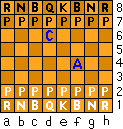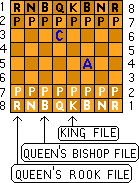| I. |
|
Algebraic Notation (preferred by most players) |
 |
RANK
NAMES |
FILE
NAMES |
|
|
|
|
A. |
Files are named by lower case small letters,
a through h. |
|
|
B. |
Ranks are named by only one number, as at the right. |
|
|
C. |
Each square is named by writing its file, followed
by its rank. Examples (blue letters in figure):
"A" is named f4; "C" is named d6. |
|
|
D. |
To record a move in Algebraic notation, write as follows: |
|
|
|
1. |
The symbol for the piece to be moved
(p,B,N,R,Q,K); this is often omitted if
step D2 below clearly describes the
move. |
|
2. |
(if capturing) write "x", followed by
the symbol of the captured piece.
Examples: pxp, NxQ.
(if not capturing) write the name of the
square moved to; the dash of descriptive
notation is usually omitted in
algebraic. |
|
3. |
If 2 pieces could both be described by
D1 or D2 above, write the location of the
intended piece in parentheses.
Examples: p(d4)xR, N(f3)e5 meaning
"N at f3 moves to e5" |
|
4. |
King's side castling is designated O-O |
|
5. |
Queen's side castling is designated O-O-O |
|
6. |
Capturing "en passant" or "in passing" is
designated "ep"; if your are unaware of
"ep", ask your prof to demonstrate. |
|
7. |
A move resulting in a check of the king
is followed by "ch". |
|
8. |
"!" means "good move"; "?" means "bad
move", written after the move. These
optional symbols are used sparingly. |
|
|
|
E. |
As in descriptive notation, organize your game
record in 2 columns, left for white, right for
black; a standard 8½ by 11 sheet of paper should
contain 2 sets of 2 columns (that is, 4 columns).
Number the rows in each pair of columns consecutively.
Write the names of competing players at the top of
his/her column. When the game is ended, the two
written records (one for each player) will be
identical if both used Algebraic. A sample game
record form is available.
Each player is expected to promptly write each move
in his/her own handwriting. Good players usually
write moves down before making them on the board. |
|
|
| II. |
|
Descriptive Notation (an older American style) |
RANK
NAMES
FOR
BLACK
MOVES |
 |
RANK
NAMES
FOR
WHITE
MOVES |
|
|
|
A. |
Each file is named for the pieces at it's
top and bottom ends as the game begins
(3 files are shown at the right). |
|
|
B. |
Each rank has 2 names, one for black's moves,
the other for white's moves: see figure. |
|
|
C. |
A square is named by writing its file,
followed by its rank. Examples (see figure at right):
(for black moves) "A" is KB5 and "C" is Q3;
(for white moves) "A" is KB4 and "C" is Q6.
Thus, in DESCRIPTIVE NOTATION, squares have
2 names, depending on who is moving. |
|
|
|
D. |
|
To record a move in Descriptive notation, write as follows: |
|
1. |
The symbol for the piece to be moved
(p,B,N,R,Q,K). |
|
2. |
(if capturing) write "x", followed by the
symbol of the captured piece. Examples:
pxp, NxQ.
(if not capturing) write a dash "-",
followed by the name of the square moved to,
from the perspective of whoever is moving,
black or white (see C above). |
|
3. |
If 2 pieces are both be described by D1 or
D2 above, write the location of the intended
piece in parentheses. Examples:
p(Q4)xR, N(KB3)-K5 meaning "N at KB3 moves
to K5" |
|
4. |
King's side castling is designated O-O |
|
5. |
Queen's side castling is designated O-O-O |
|
6. |
Capturing "en passant" or "in passing" is
designated "ep"; if your are unaware of
"ep", ask your prof to demonstrate. |
|
7. |
A move resulting in a check of the king
is followed by "ch". |
|
8. |
"!" means "good move"; "?" means "bad
move", written after the move. These
optional symbols are used sparingly. |
|
|
|
E. |
As in Algebraic notation, organize your game
record in 2 columns, left for white, right for
black; a standard 8½ by 11 sheet of paper should
contain 2 sets of 2 columns (that is, 4 columns).
Number the rows in each pair of columns consecutively.
Write the names of competing players at the top of
his/her column. When the game is ended, the two
written records (one for each player) will be
identical if both used Algebraic. A sample game
record form is available.
Each player is expected to promptly write each move
in his/her own handwriting. Good players usually
write moves down before making them on the board. |
|
|



